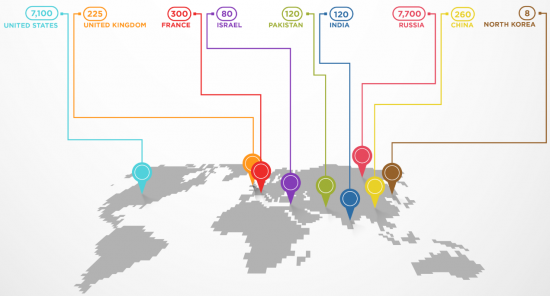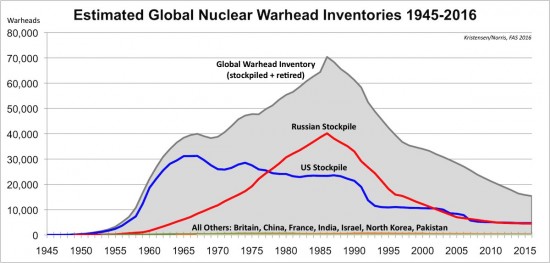
 The visit by President Obama to Hiroshima a little over a week ago made me think about the legacy we still live with because of the invention of nuclear weapons. The United States and Russia are the two nuclear superpowers on the planet. Their combined estimated inventories amount to 15,350. That is more than the nuclear weapons owned by the remaining seven countries that have joined the nuclear club. In fact it is 13 times that number.
The visit by President Obama to Hiroshima a little over a week ago made me think about the legacy we still live with because of the invention of nuclear weapons. The United States and Russia are the two nuclear superpowers on the planet. Their combined estimated inventories amount to 15,350. That is more than the nuclear weapons owned by the remaining seven countries that have joined the nuclear club. In fact it is 13 times that number.

Only twice in history have these weapons been used in war. Both were dropped on Japanese cities in the dying days of World War II. The rationale for their use was to save lives, not Japanese but American who hoped that deploying the bombs would end the need for an invasion of Japan’s home islands. The bombs probably did the trick although the Soviet Union’s entry into the war against Japan in August of 1945 meant the Japanese were no longer facing a weak continental enemy, but the strongest conventional military force on the planet, the Russian army.
President Obama spoke of pursuing “a world without nuclear weapons” when he spoke in Hiroshima. He talked about the bombings of Hirsohima and Nagasaki as a “moral awakening” to the extremes that warfare can unleash. And once more it spoke to all of us on the planet about the grave risk we continue to face because of the existence of these weapons.
Today the United States and Russia are at a crossroads. Through a number of interim steps over the last several decades as detente grabbed hold the two reduced their stockpiles of bombs. But still today each has held on to approximately 7,000. Most of them are forty or more years old. The systems that operate them are obsolete. In the United States it costs $61 billion per year to maintain systems so old that many continue to operate using 8-inch floppy disks. To give you a sense of just how old this technology is, a single 32 Gigabyte memory stick today stores the information equal to 130,000, 8-inch floppies.
For Russia the challenges are similar. Many of their nuclear weapons are controlled and fired manually. That makes their arsenal far more subject to human error.

Today over 5,000 of the American and Russian nuclear arsenal are offline. In the remaining 10,000 about 4,000 are operationally deployed with military forces around the globe. Between 4,500 and 4,700 are stockpiled. And the balance are in the shop. So it would seem that this is the time to consider a change of course. The United States can overhaul its entire nuclear weapons program or consider an alternative, a meeting of all the nuclear nations to come up with a permanent stand down order. The cost of an overhaul is estimated to be one trillion dollars. It would mean replacing the entire arsenal with 21st century equipment capable of pinpoint accuracy and destructiveness. Russia cannot afford to do this. A trillion dollars invested in refreshing its nuclear arsenal would bankrupt the country.
Today with the exception of North Korea, no nation threatens any other with a first-strike nuclear strategy. And in the case of North Korea, capability and capacity remain deficient. So much of the rhetoric is no more than bluster and petulance. But that doesn’t address the much bigger 21st century problem, all of this nuclear weapons’ technology lying around remains a threat to the planet and life as we know it. Some argue that the nuclear threat is almost equivalent to the that brought on by rising levels of carbon dioxide in the atmosphere, also human derived.
What is the real number needed for effective nuclear deterrence? Experts argue that a few hundred is all that is needed. That kind of inventory would be enough to obliterate the major cities of both America and Russia. Reducing inventories to these types of numbers would save hundreds of billions of dollars which could be better used to tackle building carbon sequestration capacity, renewable energy, and developing nuclear fusion technology to produce energy without waste.
As the President of the United States stood at Hiroshima’s Peace Memorial Museum, with a view of the GenbakuDome, the memorialized remnants of the building seen below that is the symbol of what a nuclear holocaust can do, he talked about a “future we can choose, a future in which Hiroshima and Nagaski are known not for the dawn of atomic warfare.”



